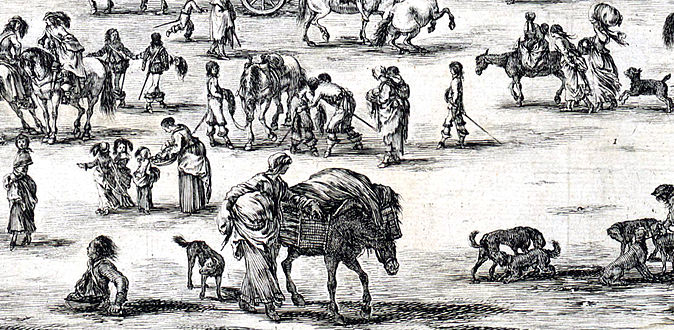Stefano della Bella
Stefano Della Bella | |
|---|---|
Engraver | |
| Movement | Baroque |
Stefano della Bella (17 May 1610.
Early life in Florence
Della Bella was born at
Work in Rome
Having arrived in Rome in 1633,
-
Entry of the Polish Ambassador to Rome, 1633
-
Polish horseman etching
Paris and the return to Florence
In 1639, della Bella went to Paris and lived there until 1650. He adapted his style to French tastes, and was influenced by Rembrandt and other Dutch print makers. Della Bella made trips to Holland and North Africa.[9]
The majority of della Bella's prints date from the years in Paris; he had arrived four years after the death of Callot, and was already known to important French publishers. In 1641
Della Bella also engraved views of Paris, including a very large print of the
-
View of the Pont Neuf, 1646
-
Detail with figures
French anti-Italian feeling during the
Notes
- ^ Massar 1996. De Vesme 1906, p. 68, states he was baptised on 18 March and born the same day.
- ^ Reed 1989, 234; Massar 1996.
- ^ a b c d Chishholm 1911.
- ^ a b c d Massar 1996.
- ^ a b c d e Massar 1968, p. 160.
- ^ Massar 1971, p. 4.
- ^ Massar 1971, p. 5.
- ^ Massar 1996; Reed 1989, pp. 234–236.
- ^ Reed 1989, p. 234.
- ^ Reed 1989, p. 242; Massar 1996.
Bibliography
- Chisholm, Hugh, ed. (1911). . Encyclopædia Britannica. Vol. 7 (11th ed.). Cambridge University Press. p. 965.
- De Vesme, Alexandre (1906). "Étienne Della Bella", pp. 66–79 and "Oeuvre d'Étienne Della Bella", pp. 79–332", in Le Peintre-Graveur italien (at Internet Archive). Milan: Ulrico Hoepli.
- JSTOR 3258383.
- Massar, Phyllis D. (1971). Stefano Della Bella, Catalogue Raisonné. Alexandre De Vesme with Introduction and Additions by Phyllis Dearborn Massar. New York: Collectors Editions.
- Massar, Phyllis D. (1996). "Bella, Stefano della", vol. 3, pp. 631–634, in (accessed 22 November 2010).
- Reed, Sue Welsh & Wallace, Richard, editors (1989). Italian Etchers of the Renaissance and Baroque, Museum of Fine Arts, Boston. ISBN 0-87846-306-2or 304-4 (pb)
External links
- Works by Stefano della Bella at the Museum of New Zealand Te Papa Tongarewa
- Stefano della Bella Etchings , Getty Research Institute, Los Angeles, Accession No. P830003. The collection includes four suites of etchings by Stefano della Bella, comprising 35 prints. Primarily decorative, they depict genre scenes of people and animals (in rural settings), fantastic vases, panels of grotesques, and the Medici Villa Demidoff and its gardens near Florence.




